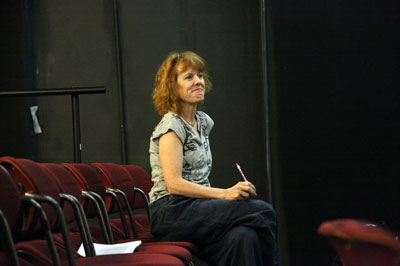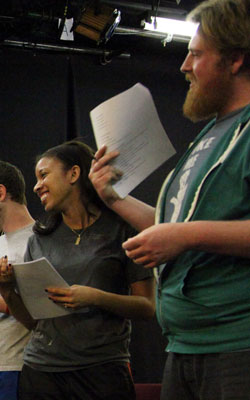There’s Nothing Like Prison …
Thursday, July 16, 2015

Once upon a time, an OSU assistant professor of acting and a group of her mosttalented
students went to prison. None of them had committed a crime nor were they being punished.
In fact, each of them felt privileged.
“It was a great experience, something I will never forget,” OSU sophomore Kia Dorsey
says.
Make no mistake, apprehension existed and even tears were shed, but there was also
laughter and, ultimately, understanding. By pulling her students so far out of their
comfort zone, Jodi Jinks saw the vision of her ArtsAloud-OSU program realized at the
John H. Lilley Correctional Center in Boley, Okla.
It was April 18, 2014 — truly an “Orange Friday” if you consider the prison uniform
— and Jinks brought her students to the facility to perform for the inmates. Acting
out any script in that environment would induce goose pimples, but Jinks’ approach
added a new level of anxiety. She teaches “devised theatre,” in which the inmates
worked with her to tell their stories and create a performance. They had already performed
this material for their fellow prisoners, but now the OSU students were going to play
that same material back to those who lived the stories and penned the script.
Imagine playing the part of a man nicknamed “Bear” directly in front of him.
“This kid of acting experience takes the notion of ‘embodied learning’ to another
level,” professor and head of the theatre department Andrew Kimbrough says. “The students
get a very powerful sense of the lived experience of the inmates/writers.”
Jinks established this program at OSU after earning the Mary Lou Lemon professorship
in January though she began this type of work several years ago at women’s prisons
in Texas. Her first effort in Oklahoma brought her (and volunteer Linda Smolen, who
served as co-director of the play) to a minimum-security, all-male facility, and though
the gender of her subjects changed in Oklahoma, the overall reaction did not.
“They’re thankful for the interaction,” Jinks says. “I think they’re loving the fact
that they’re being hear, that they have a story people actually want to hear.”
After several months of writing and collaborating with Jinks, the inmates created
a show called Reflections of Time, which chronicled “the challenges, the joys, and
the dreams of these particular men, and reminds us that we are all so much more than
our worst choices.” A month before the OSU students arrived, the inmates performed
the show for their contemporaries. The script was packed with inside jokes and included
poetry, short scenes and even a band with inmates who did not take part in the class.
“It just went so well,” Jinks says.
OSU graduate student Lacy Delaino was among the small group of people from outside
the prison to observe the show.
“I had no expectations of it whatsoever,” Delaino says. “But they performed in such
an incredible way.”
The subject matter, perhaps not surprisingly, often touched on forgiveness but also
included stories of who they were before prison and even who they had become while
inside the correctional center. It sounds like a therapeutic process, but Jinks is
quick to point out her role is to help them create a work of art.

“I am not a psychologist,” Jinks says emphatically. “I stay away from the dark material
because I don’t have the skills to do anything with that. When I hear people talk
about ‘healing’ in association with this work, I want to push back.”
Nevertheless, the inmates’ performance in front of their fellow prisoners proved
to be an emotional experience. Delaino says those in the audience commented after
the show how thankful they were to see their fellow inmates share details and stories
they may have kept quiet in day-to-day interactions. They laughed and, yes, they cried.
“The most surprising part was to see the vulnerability in these men and that they
were willing to show it in front of their peers,” Delaino says.
The task for the seven OSU student actors was to capture that vulnerability, find
the humor, and play the story back to the inmates inside the Lilley Correctional Center.
The students had limited time to rehearse — and several were involved in OSU Theatre’s
production of Man of La Mancha, which debuted a week later — but they delivered a
performance that seemed to please both their instructor and the audience.
Zack Graham, then a senior at OSU, says he was not scared or nervous about entering
the prison but more apprehensive about “messing up” the show these men had written.
“Watching them watch us was an emotional experience,” he says. “It surprised me how
emotional I got. Once we got their reactions, it was kind of like, ‘Oh, I have emotions,
too.’”
The slightly informal setting of the prison’s chapel lent itself to a more reciprocal
experience than a typical show on a stage in a theater. During dress rehearsal, Jinks
warned the students that parts of the show would inspire members of the audience to
respond. She pushed her actors to embrace such interaction and to even encourage it.
Dorsey related that in a few scenes they left out a word or adjective, forcing the
actors to enlist the audience for help in filling in the blanks. At another point,
Jinks directed actor D.J. Grigsby, who had the task of playing “Bear,” to go up to
the inmate himself and say, “Hello, Mr. Handsome!” during the monologue.
Moments such as the latter drew tremendous laughter, no doubt a welcome release in
between teardrop-inducing pieces with titles like “How to Trust” and “Forgiveness
and More.” According to Jinks, the inmates embraced the young actors’ interpretations.
“They were very impressed with the skills of the acting students. Some of them ‘Well,
that’s what I was trying to do with my part!’ ”
After the students performed, they held a question-and-answer session with the inmates.
Dorsey and Graham both noted how much the prisoners enjoyed seeing trained actors
deliver the script. Suddenly confronted with seeing both sets of very different students
in the same space (“I felt like my parents were meeting my future in-laws”), Jinks
spent most of the time watching the inmates.
“I saw some people crying as they saw their pieces read back to them,” she says.
“I remember looking at Kevin, who’s 6-foot- 7, and seeing his mouth wide and his eyes
wide, watching this student read his part. He was glowing.”
That performance ended a sixth-month journey for Jinks and the inmates. She received
four letters shortly after the event, all complimentary, and the inmates asked for
additional writing assignments. She will return in the fall to continue working at
the Lilley Correctional Center and has already expanded the ArtsAloud-OSU program,
with Delaino taking the lead at Jess Dunn Correctional Center in Taft, Okla. Jinks
hopes to add another prison and more volunteers soon.
Gratitude became the fruit of her first mission with ArtsAloud-OSU. From the inmates
reflecting on their time to their own performance, to then watching trained OSU actors
tell the story they had written, to the actors feeling privileged to perform in front
of, and meet, the authors, every turn produced reciprocal gratitude.
On April 18, 2014, at the John H. Lilley Correctional Center, a group of OSU students
went to prison. They could not have been more thankful.
Story By Brian Petrotta
